Metal for Life with Metal Mike: A Practice Piece That Incorporates Useful, Challenging Techniques

In my quest to raise my guitar-playing game to the highest level, I find it essential to devise practice techniques that will push my pick- and fret-hand abilities as far as possible.
A great way to go about this is to combine the focus on these technical issues with the creative endeavor of writing original riffs and patterns that will hopefully spark new song ideas.
FIGURE 1 is a 19-bar etude—a musical exercise that sounds like a mini-composition—I came up with that effectively addresses several fret- and pick-hand techniques that I consider crucial to mastering the art of metal guitar playing.
In bars 1–4, I alternate a series of two-note power chords on the A and D strings against the palm-muted open low E string, which functions as a pedal tone. Notice that the E note on the A string’s seventh fret is common to each of the two-note chord shapes as the higher note on the D string ascends chromatically (one fret at a time).
In this way, I’ve incorporated a melodic idea into a hard-driving rhythm part. At the end of bar 2, the note on the D string descends in order to set up the restatement of the pattern in a musically satisfying way.
In bars 5 and 6, I initially accentuate an E5 power chord on the downbeat of beat one, and then repeatedly accent this chord every three 16th notes. The twist here is that, after the initial attack on each E5 chord, I hammer on from B to C on the A string, which creates a subtle grind that makes the riff sound heavy.
Then, in bars 7 and 8, I switch to a single-note figure played in straight 16th notes across the bottom two strings, palm-muting the low E virtually the entire time in order to enhance the idea’s rhythmic power. In bars 9–12, I bring back the rhythmic approach from bar 1 but with different chords: here, a low E5 power chord is followed by C, Cs and D voicings on the A, D and G strings. Once again, I employ quick hammer-ons as I shift from chord to chord.
The idea then wraps up in the final seven bars, starting in bars 13–15 with a lick played in steady 16th notes and built around consecutive pull-offs that are performed quickly while rapidly moving across the bottom three strings. I use a different fretting finger on each string—index on the low E, middle on the A and ring on the D—and it will take some practice to master this lick and get it up to the desired brisk tempo.
The aggression culminates in bar 16 with a fast descending run that also moves across the bottom three strings, starting with 16th-note-triplet double pull-offs that incorporate a four-fret stretch as I move from the pinkie to the middle finger to the index finger. At the end of the pattern—bar 16, beat four—I shift up the neck slightly and switch the fretting fingers to pinkie, ring and index.
All in all, this is a fun and challenging etude. Be sure to work it up to tempo gradually with attention paid to clear and precise articulation.

Get The Pick Newsletter
All the latest guitar news, interviews, lessons, reviews, deals and more, direct to your inbox!
